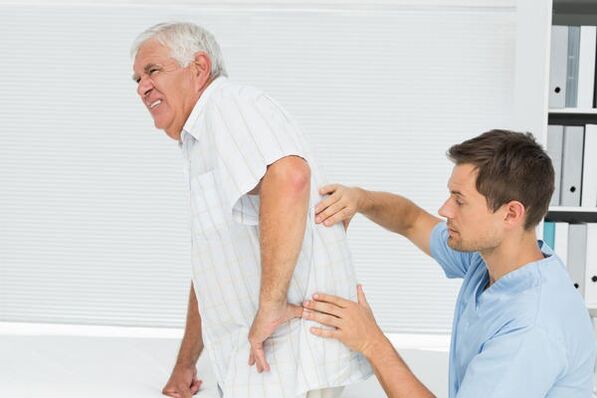Low back pain is one of the most common reasons that force the patient to seek help from a neurologist or therapist. Lumbosacral spine pain can be permanently disabling, making movement and self-care impossible. Acute low back pain affects men and women equally. More frequently in middle and old age, low back pain can be seen in adolescents and young adults. This is due to rapid growth, weakness in the fragile muscles of the lower back, injuries. Therefore, lumbosacral spine pain is the most pressing problem anyone can face.

Possible causes of back pain in the lower back
Lumbosacral spine pain may be associated with processes that occur both in the spine and outside it.. . . Consider the main pathological conditions in which acute low back pain may be seen.
A herniated disc is formed when the annulus fibrosus ruptures and the nucleus pulposus compresses the elements of the nerve roots that exit the spinal cord. Compression causes pain in the lower back to become extremely intense, sometimes unbearable. Lumbosacral spine pain with herniated disc may be accompanied by sensory disturbances and various types of numbness in the corresponding segments of decompression (compression). Low back pain radiates (gives) to the lower limb, causing muscle tension due to the spasm. With a prolonged course, a herniated disc causes chronic pain in the lumbosacral region. The muscular tension in the back, being constant, increases the pain syndrome even more, making it chronic.
In addition to these conditions, pain in the lower back may be due to the following reasons not associated with vertebrogenic defects:
- kidney diseases, renal pelvis(exacerbation of chronic pyelonephritis), kidney urolithiasis, neoplastic kidney diseases, and tumor metastases to the kidneys. At the same time, the pain in the lower back is located a little higher (at the projection site of the kidneys), the pain in the lumbosacral region is not very typical. Pain is accompanied by other characteristic changes (frequent urination, dysuria, changes in urinalysis, temperature reaction);
- upper digestive tract diseases(peptic ulcer, pancreatic inflammation, pancreatic cancer) in a particular location sometimes manifest as pain in the lumbosacral region. But back pain is not associated with movement, it may be associated with other complaints (vomiting, fecal disturbances, nausea, burning along the esophagus);
- Acute back pain, in some cases, may occur.for various inflammatory diseases of the female genital area.(annexitis, endometriosis), cancer (uterine cancer), fibroids, abdominal cavity tumors. Low back pain in women sometimes occurs during menstruation or just before menstruation. During pregnancy, there may also be a feeling of heaviness and pain in the lower back and sacrum;
- deforming osteoarthritis of the hip joint(coxarthrosis), especially with an exacerbation of the process, in addition to gait disturbance, difficulty walking, it can cause pain in the lumbosacral region, in the region of the muscles of the gluteal region on the corresponding side of the injury, tension in the muscles of the lower back and buttocks.
Acute low back pain: what to do?
If the patient experiences severe low back pain in the lower back, it is necessary to immediately seek the help of a qualified specialist to diagnose the cause of the pain that has appeared. More often, the patient goes to a neurologist, where, after proper diagnoses (X-ray exam, CT scan, MRI) and a neurological examination, he is diagnosed with a spinal disease.
In the absence of convincing data for spinal pathology (osteochondrosis, herniated disc), additional methods (ultrasound of internal organs, densitometry, pelvic ultrasound) and consultation with related specialists (oncologist, gynecologist, endocrinologist) may be necessary.
Treatment of back pain in the lower back
Acute low back pain, as prescribed by a physician, is stopped by non-steroidal anti-inflammatory medications (in the form of pills or injections), the appointment of muscle relaxants, rest, bed rest, applications of anti-inflammatory ointments, the imposition of compresses . Treatment in the acute phase can be carried out in a stationary environment or in a polyclinic.
Prescribe drugs that improve microcirculation, with acute low back pain, blockage is used. Sometimes, with the ineffectiveness of other types of therapeutic effects, they resort to surgical treatment (compressing the nerve roots). When combined with osteoarthritis, chondroprotectors are used for a long time in osteoporosis - calcium and vitamin D3 preparations. Physiotherapeutic effects (provided there are no contraindications), physiotherapeutic exercises and in the rehabilitation phase - follow-up treatments can be used in sanatoriums.





































